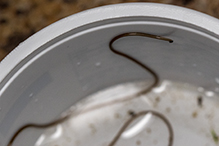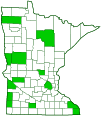horsehair worms
(Order Gordioidea)
Overview • Description • Distribution • Taxonomy
Description |
||
Adults are very long, hair-like worms. They are 1⁄32″to ⅛″ (1 to 3 mm) in diameter and are usually 12″ to 16″ (30 to 40 cm) long but some can grow up to 47″ (120 cm) in length. The body color is purplish-brown to black in most species, tan in some species. There is a blunt head and a swollen tail, but there are otherwise no distinguishing features that can be seen in the field without magnification. The body is unsegmented and is covered by a thick, two-layered cuticle. The outer layer often has groups of wart-like or pimple-like bumps (areoles). It does not have lateral rows of hairs (setae), but it does have bristles that aid in swimming. There is a vent (cloaca) at the rear end of the body but there is no mouth. Inside there is a ventral cord containing nerve tracks but no similar dorsal cord. |
||
Distribution |
||||
|
Sources |
|||
| 11/5/2021 | ||||
Taxonomy |
|||
Kingdom |
Animalia (animals) | ||
Phylum |
Nematomorpha (horsehair worms) | ||
Class |
Gordioida | ||
Subordinate Taxa |
|||
Family Chordodidae Family Gordiidae |
|||
Synonyms |
|||
|
|||
Common Names |
|||
The order Gordioidea has no common name. The common name of the phylum Nematomorpha is horsehair worms, and is used here for convenience. |
|||
Glossary
Cloaca
The single posterior cavity, often called the vent, that serves as an opening for the release of intestinal waste, urinary waste, and sperm in most vertebrates (except most mammals) and some invertebrates.
Seta
A stiff, hair-like process on the outer surface of an organism. In Lepidoptera: A usually rigid bristle- or hair-like outgrowth used to sense touch. In mosses: The stalk supporting a spore-bearing capsule and supplying it with nutrients. Plural: setae.
What’s in a Name?
The common name of the phylum “horsehair worms” comes from the belief that a horse hair can turn into a worm.
The scientific name of the class Gordioida refers to the way that male and female nematomorphs coil themselves into a tight ball during mating that resembles a Gordian knot.
Visitor Photos |
|||||
Share your photo of this horsehair worm. |
|||||
| This button not working for you? Simply email us at info@MinnesotaSeasons.com. Attach one or more photos and, if you like, a caption. |
|||||
Greg Watson |
|||||
Horsehair worm I attached a video and a picture of a horsehair worm that I found in my water feature filter. It was really difficult to get a good picture of it because of its small diameter and movement. I then took a video of it with my phone. |
 |
||||
MinnesotaSeasons.com Photos |
|||||
|
|||||

Slideshows |
||

Visitor Videos |
|||
Share your video of this horsehair worm. |
|||
| This button not working for you? Simply email us at info@MinnesotaSeasons.com. Attach a video, a YouTube link, or a cloud storage link. |
|||
Greg Watson |
|||
| horsehair worm Gordioidea 01 5/11/2021 |
|||
About
10/13/2021 I attached a video and a picture of a horsehair worm that I found in my water feature filter. It was really difficult to get a good picture of it because of its small diameter and movement. I then took a video of it with my phone. |
|||
Other Videos |
|||
| ハリガネムシ(hairworms; horsehair‐worms; Gordioidea Kinu-chan |
|||
About
Aug 8, 2021 |
|||
| Parasite Comes Out of Praying Mantis heroshotGG |
|||
About
Jul 24, 2012 Parasite comes out of Praying Mantis. What is it? |
|||
| 경악!!! 사마귀에서 연가시 8마리 Gordioidea no africa |
|||
About
Nov 16, 2012 헐 ㄷㄷㄷ8마리 |
|||
| 경악!!! 사마귀에서 연가시 Paragordius tricuspidatus from mantis Gordioidea no africa |
|||
About
Nov 10, 2018 경악!!! 사마귀에서 연가시 꿈틀꿈틀 Google Translate: astonished!!! Wriggling from a praying mantis |
|||
| Гидробиология Забайкалья. Конский волос, волосатик (Nematomorpha: Gordioidea) Dmitry Matafonov |
|||
About
Apr 8, 2017 The underwater video of horsehair worm (Nematomorpha: Gordioidea) in Lake Gusinoe, Buryatia (Russia). Подводное видео волосатика (Nematomorpha: Gordioidea) в озере Гусиное (Бурятия). Волосатик (в народе "конский волос") паразитирует в наземных беспозвоночных животных и не опасен для человека. Google Translate: Underwater video of a hairy whale (Nematomorpha: Gordioidea) in Lake Gusinoe (Buryatia). The hairy worm (popularly "horsehair") is a parasite in terrestrial invertebrates and is not dangerous to humans. |
|||

Visitor Sightings |
|||||
Report a sighting of this horsehair worm. |
|||||
| This button not working for you? Simply email us at info@MinnesotaSeasons.com. Be sure to include a location. |
|||||
| Greg Watson 7/6/2021 |
Location: La Crescent MN I attached a video and a picture of a horsehair worm that I found in my water feature filter. It was really difficult to get a good picture of it because of its small diameter and movement. I then took a video of it with my phone. |
||||
MinnesotaSeasons.com Sightings |
|||||
|
|||||

Created: 11/6/2021
Last Updated:

